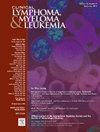贝兰他单抗马福多汀在复发和/或难治性多发性骨髓瘤患者中的治疗模式、疗效和耐受性:一项现实世界分析。
IF 2.7
4区 医学
Q2 HEMATOLOGY
引用次数: 0
摘要
目的:Belantamab mafodotin是一种用于复发/难治性多发性骨髓瘤(RRMM)患者的抗b细胞成熟抗原(BCMA)免疫偶联物。需要更多关于其治疗模式、疗效和现实环境耐受性的数据。患者和方法:这项单点回顾性研究调查了30名在杜克癌症研究所接受治疗的多发性骨髓瘤患者,他们在2020年8月5日至2022年11月22日期间开始贝兰他单抗马弗多汀单药治疗。我们描述了基线临床特征、疾病反应(根据国际骨髓瘤工作组[IMWG]标准,尽可能提供骨髓活检数据)、贝兰他单抗治疗模式和眼部不良事件(根据角膜病变视力[KVA]量表)。结果:在30例患者中,治疗线的中位数为4条,20例患者(87%)为三难治性/四难治性/五难治性,7例患者(23%)为高危细胞遗传学(根据IMWG标准)。总有效率为67%。22例(73%)患者出现进展;中位无进展生存期为9.5个月(95% CI 6.6-15.6)。3年随访时,中位总生存期未达到。19例患者(63%)出现剂量减少;65%是眼部不良事件,30%是血液学不良事件。周期延迟28例(93%);85%是由于眼部不良事件。角膜病变(任何级别)28例(93%);2%的事件≥3级。视力(任何级别)改变27例(90%);3.3%的事件为≥3级。4例(13%)因眼毒性而停止治疗。结论:尽管可控性角膜病变的发生率很高,但这些数据表明,在剂量/周期调整的较长时间内,贝兰他单马福多汀对RRMM患者有益。注册:临床试验。政府:NCT05986682。本文章由计算机程序翻译,如有差异,请以英文原文为准。
Treatment Patterns, Efficacy, and Tolerability of Belantamab Mafodotin in Patients With Relapsed and/or Refractory Multiple Myeloma: A Real-World Analysis
Purpose
Belantamab mafodotin is an anti-B cell maturation antigen (BCMA) immunoconjugate for patients with relapsed/refractory multiple myeloma (RRMM). Additional data on its treatment patterns, efficacy, and tolerability in real-world settings are needed.
Patients and Methods
This single-site, retrospective study examined 30 adults with multiple myeloma receiving care at Duke Cancer Institute who began belantamab mafodotin monotherapy between 8/5/2020 and 11/22/2022. We described baseline clinical characteristics, disease response (per International Myeloma Working Group [IMWG] criteria, as possible given available bone marrow biopsy data), belantamab mafodotin treatment patterns, and ocular adverse events (per the Keratopathy Visual Acuity [KVA] scale).
Results
Across 30 patients, the median number of lines of therapy was 4, 20 patients (87%) were triple-/quad-/penta-refractory, and 7 (23%) had high-risk cytogenetics (per IMWG criteria). Overall response rate was 67%. Progression occurred in 22 patients (73%); median progression-free survival was 9.5 months (95% CI 6.6-15.6). Median overall survival was not reached as of 3-year follow-up. Dose reduction occurred in 19 patients (63%); 65% were due to ocular adverse events, 30% hematologic adverse events. Cycle delay occurred in 28 (93%); 85% were due to ocular adverse events. Keratopathy (any grade) occurred in 28 (93%); 2% of events were grade ≥3. Visual acuity change (any grade) occurred in 27 (90%); 3.3% of events were grade ≥3. Treatment discontinuation from ocular toxicity occurred in 4 (13%).
Conclusion
Despite a high incidence of manageable keratopathy, these data demonstrate benefit in belantamab mafodotin in patients with RRMM over an extended time amid dose/cycle modifications.
Registration: ClinicalTrials.gov
NCT05986682.
求助全文
通过发布文献求助,成功后即可免费获取论文全文。
去求助
来源期刊

Clinical Lymphoma, Myeloma & Leukemia
ONCOLOGY-HEMATOLOGY
CiteScore
2.70
自引率
3.70%
发文量
1606
审稿时长
26 days
期刊介绍:
Clinical Lymphoma, Myeloma & Leukemia is a peer-reviewed monthly journal that publishes original articles describing various aspects of clinical and translational research of lymphoma, myeloma and leukemia. Clinical Lymphoma, Myeloma & Leukemia is devoted to articles on detection, diagnosis, prevention, and treatment of lymphoma, myeloma, leukemia and related disorders including macroglobulinemia, amyloidosis, and plasma-cell dyscrasias. The main emphasis is on recent scientific developments in all areas related to lymphoma, myeloma and leukemia. Specific areas of interest include clinical research and mechanistic approaches; drug sensitivity and resistance; gene and antisense therapy; pathology, markers, and prognostic indicators; chemoprevention strategies; multimodality therapy; and integration of various approaches.
 求助内容:
求助内容: 应助结果提醒方式:
应助结果提醒方式:


